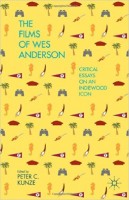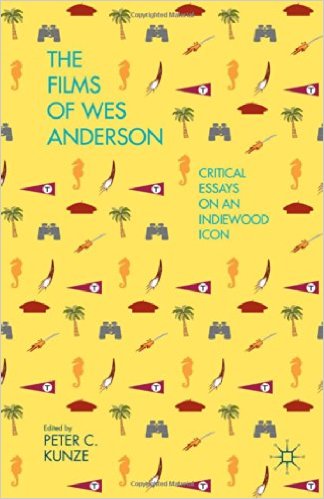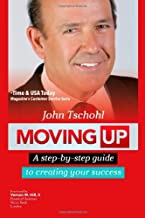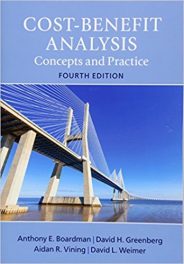 Editor: Peter C. Kunze
Editor: Peter C. Kunze
Publisher: Palgrave Macmillan – 226 pages
Book Review by: Laxmi Chaandi
Wes Anderson is an independent film maker who has won many awards, even though he may not be a household name such as Woody Allen or Steven Spielberg.
Wes Anderson’s most recent and popular film The Grand Budapest Hotel won the Best Original Screenplay award at the British Academy of Film and Television Awards (BAFTA) in 2014. It also won the Grand Jury Prize at the Berlin International Film Festival in the same year. It has also been nominated in 2015 for Academy Awards for Best Motion Picture, Best Achievement in Directing, and Best Writing: Original Screenplay.
This movie also received nominations in 2015 by the Golden Globes for Best Director and Best Screenplay. And it has won other awards and received nominations for them from lesser-known film organizations, too numerous to mention here.
That is all on just one of his movies. His other films have won awards, too. The Moonrise Kingdom won the Movie of the Year award in 2013 by the American Film Institute. It was nominated for Best Writing: Original Screenplay in 2013 by the Academy Awards. That same year the BAFTA nominated this movie for Best Original Screenplay.
Some of the other notable films Wes Anderson has created and directed are: Fantastic Mr. Fox, The Life Aquatic with Steve Zissou, and The Royal Tennenbaums.
This is a book of essays on Wes Anderson’s films, particularly on their content, messages, styles, themes, and other aspects. For the most part, the 14 people including Peter C. Kunze who have written their analyses and comments on his work are students and teachers of the art of the cinema, rather than average moviegoers. We present below the list of chapters of this book so you can see what’s in it, as well as what is not.
- Part 1
- The Short Films of Wes Anderson
- Cast of Characters: Wes Anderson and Pure Cinematic Characterization
- The Jellyfish and the Moonlight: Imagining the Family in Wes Anderson’s Films
- “Max Fischer Presents”: Wes Anderson and the Theatricality of Mourning
- “Who’s to Say?”: The Role of Pets in Wes Anderson’s Films
- “American Empirical” Time and Space: The (In) Visibility of Popular Culture in the Films of Wes Anderson
- Part 2
- From the Mixed-Up Films of Mr. Wesley W. Anderson: Children’s Literature as Intertexts
- A Shared Approach to Familial Dysfunction and Sound Design: Wes Anderson’s Influence on the Films of Noah Baumach
- Bill Murray and Wes Anderson, or the Curmudgeon as Muse
- Life on Mars or Life on the Sea: Seu George, David Bowie, and the Musical World in Wes Anderson’s The Life Aquatic
- Part 3
- The Andersonian, the Quirky and “Innocence”
- “I Always Wanted to be a Tenenbaum” Class Mobility in Neoliberal Fantasy in Wes Anderson’s The Royal Tenenbaums
- Objects/Desire/Oedipus: Wes Anderson as Late Capitalist Auteur
- Systems Thinking in The Life Aquatic with Steve Zissou and Moonrise Kingdom
To get a better and quicker idea of Wes Anderson’s films, I suggest you read the Introduction entitled The Wonderful Worlds of Wes Anderson by its editor Peter C. Kunze who teaches critical inquiry and writing about films. Kunze writes that Wes Anderson not only creates films, he also amuses, angers, challenges, charms, delights, inspires, irks, and provokes us. He makes these other observations about Wes:
- His genius lies in his ability to make something new from the wealth of sources he draws from in each film, as well as the numerous associates with whom he has ongoing personal and professional relationships, both onscreen and behind the camera.
- His films have developed into easily identifiable productions through their use of bold colors, popular music, deadpan expressiveness, and devastating one-liners that, like poetry, find their power in their concentration. Each of his films shows development and expected amount of experimentation and risk-taking, yet there are various traits that seem to echo through several, though not all, of his films.
- The most immediately detectable traits of his films are the dry delivery of his dialogue, echoing a coolness and nonchalance that some connect with a pervasive melancholy in his work. His striking use of primary colors that seem to integrate a 1960s and 1970s style into the hard-to-pin-down present; and bird-eye shots of hands, letters, and other everyday objects that contribute to both the progression of the plot and the development of characters.
Editor:
Peter C. Kunze is a Lecturer in the Writing and Critical Inquiry Program at the University of Albany, State University of New York. His research interests include comedy, masculinity, and childhood across literature, film, and new media. His current research examines sincerity in contemporary American narratives and parallels between Australian and American cinemas.
Contributors:
Joshua Gooch has published in Cinema Journal, Wide Screen, Nineteenth-Century Contexts, LIT: Literature Interpretation Theory, Texas Studies in Literature and Language, and The Iowa Journal of Cultural Studies. He is an assistant professor at D’Youville College in Buffalo, NY.
Lara Hrycaj is an Adjunct Instructor in Media Arts and Studies at Wayne State University and a Lecturer in Mass Communication at Hillside College. She recently earned her PhD at WSU with her dissertation “What Is Music?” Auteur Music in the Films of Wes Anderson
Rachel Joseph is Assistant Professor of Theatre at Trinity University. She earned her PhD in Drama from Stanford University. She has an MFA in Creative writing and an MA in Theatre Studies from the University of Arizona.
Colleen-Kennedy Karpat is the author of Rogues, Romance and the Exoticism in French Cinema of the 1930s, winner of the Northeast Modern Language Association Book Award. She teaches film and media studies at Bilkent University in Ankara, Turkey.
C. Ryan Knight teaches composition and literature at Randolph Community College in Asheboro, North Carolina.
James MacDowell is Assistant Professor in Film Studies at the University of Warwick and the author of Happy Endings in Hollywood Cinema: Clichés, Convention, and the Final Couple. He sits on the editorial board of Movie: A Journal of Film Criticism.
Jennifer O’Meara, a PhD candidate in film studies at Trinity College Dublin, focuses her research on verbal style in art cinema. Her writing has appeared, or is forthcoming in Verse, Voice and Vision: Poetry and the Cinema, Cinema Journal, and Literature/Film Quarterly
Jen Hedler Phyllis is a PhD candidate at the University of Illinois in Chicago. Her dissertation “Lyric Histories,” traces the appearance disappearance of history in twentieth-century American poetry, arguing that development of the historical in modernist and contemporary poetry mirrors economic developments both in the U.S. and Europe.
Nicole Richter is Associate Professor in, and Area Coordinator of the Motion Pictures Program at Wright State University in Dayton, Ohio. Her work has been published in the Journal of Bisexuality, Short Film Studies, Feminism at the Movies, and Queer Love in Film and Television.
Steven Rybin is Associate Professor of Film at Georgia Gwinnett College. He is the author of Terence Malick and the Thought of Film, Michael Mann: Crime Auteur, and coeditor of Lonely Places, Dangerous Ground: Nicholas Ray in American Cinema.
Jason Davids Scott teaches at Arizona State University. His area of focus include film and theater history, performance studies, and popular culture. He has taught at Stephen F. State University in Texas and the University of California – Santa Barbara.
Laura Shackelford is Assistant Professor of English at the Rochester Institute of Technology. In Tactics of the Human: Experimental Techniques in American Fiction she examines literary experiments with early digital cultures of the 1990s.
Kim Wilkins is a PhD candidate at the University of Sydney, Australia. Her work explores American eccentricity as a mode of contemporary American cinema that makes use of ironic expression, parody, and pastiche to express sincere anxieties.







